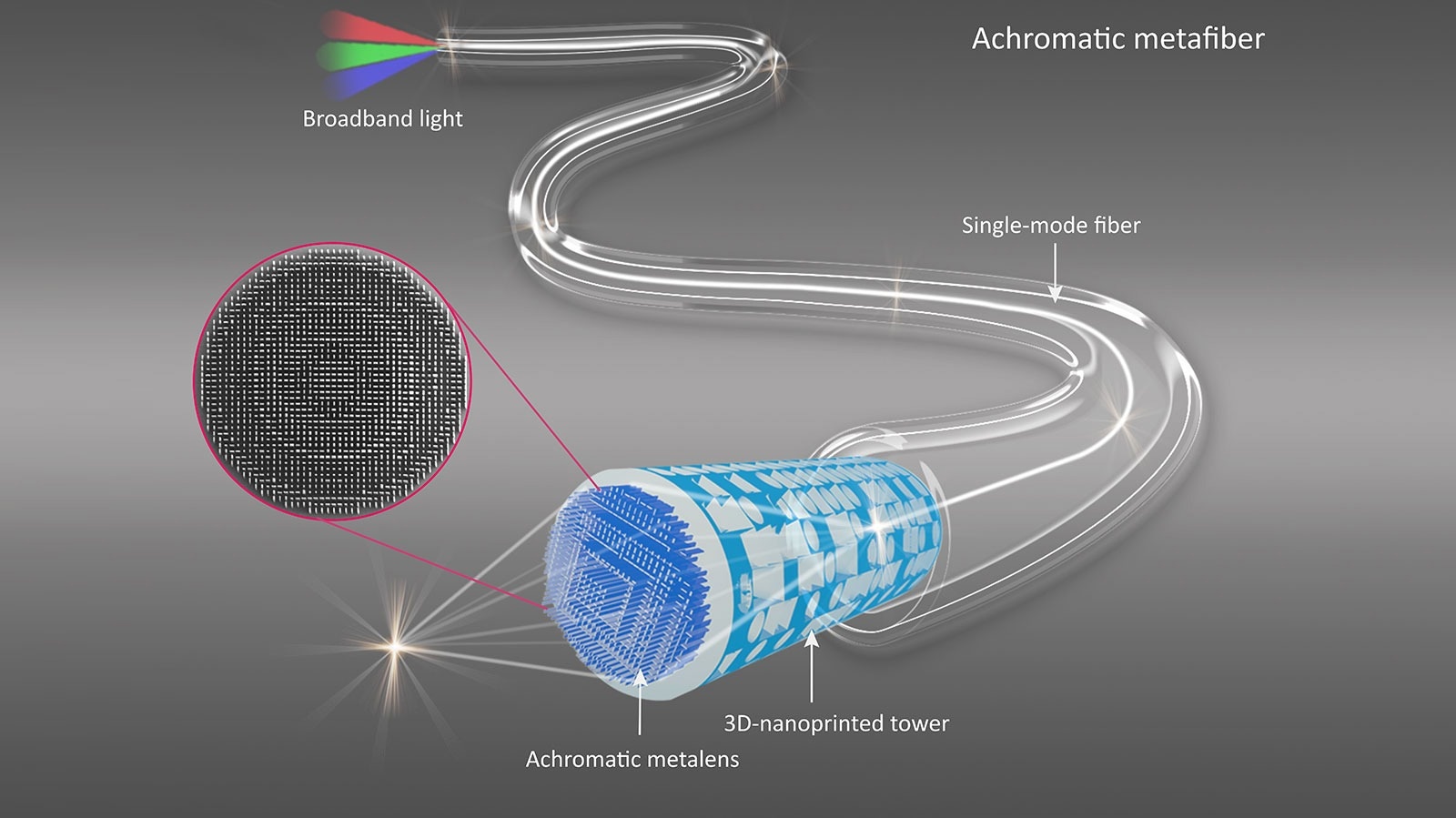Reviewed by Mila PereraOct 27 2022
With the help of the Leibniz Institute of Photonic Technology (Leibniz IPHT), an interdisciplinary team of researchers from Germany, Australia, Korea, and the United Kingdom was able to optimize an optical glass fiber for the first time, allowing light of various wavelengths to be focused extremely precisely.

An achromatic polymer lens is applied to the end of an optical fiber using 3D nano-printing, which achromatically focuses light over many wavelengths. Image Credit: Haoran Ren/Monash University
An optical lens attached to the fiber end is 3D nanoprinted to the desired level of precision. This creates new opportunities for laser treatment, sensor technologies, endoscopy, microscopy, and other uses. The journal Nature Communications published the researchers’ findings.
Lenses at the end faces of optical fibers currently used in endoscopy for medical diagnostics have the drawback of chromatic aberration.
Since various wavelengths of light, or distinct spectral colors, are curved and refracted differently, this imaging defect of optics causes a shift in the focus point, which causes blurring in imaging over a broad range of wavelengths. Achromatic lenses offer a solution since they can reduce these optical imperfections.
An international team has now achieved the first implementation of such an achromatic lens, known as a “meta lens,” which is attached to the end of an optical fiber and permits focusing and imaging of minute details with depth-of-field imaging.
For ideal light shaping and achromatic focusing, we realized an ultrathin polymer-based lens, which consists of a complex design of geometric structures in the form of nanopillars. This structure was printed directly on the tip of a 3D-printed hollow tower structure on one of the end faces of a commercial optical fiber.
Professor Dr. Markus Schmidt, Head, Fiber Photonics Department, Leibniz Institute of Photonic Technology
Dr. Schmidt added, “In this way, optical fibers can be functionalized in such a way that light can be focused very efficiently on a focal point and images with high resolution can be generated.”
The researchers developed a meta lens with a 100-micrometer lens diameter and a numerical aperture (NA) of 0.2, which is substantially greater than previously employed achromatic lenses on the end of fiber end faces and results in improved resolution.
The lens allows light to be focused accurately with a 400-nanometer infrared spectral bandwidth and the rectification of optical aberrations.
“It is remarkable that the individual nanopillars have different heights ranging from 8.5 to 13.5 micrometers. This allows the different wavelengths of light to be focused on a single focal point,” stated Dr. Schmidt.
Using fiber-based confocal scanning imaging as an example, the researchers demonstrated the lens and focusing efficiency of the created fiber optics in experimental investigations.
They produced convincing image quality with high image acquisition efficiency and high image contrast at various wavelengths using a fiber with achromatic meta-optics. Even while using various wavelengths, the focus positions remained essentially consistent.
Since the developed nanostructured meta lens is extremely small and flat, a fiber optic design with achromatic optics at the top offers the potential to further advance miniaturized and flexible endoscopic imaging systems based on fiber technology and to enable even more gentle minimally invasive examinations.
Professor Dr. Markus Schmidt, Head, Fiber Photonics Department, Leibniz Institute of Photonic Technology
The researchers also anticipate further applications in fiber-optic communication, fiber sensor technologies, and laser-assisted treatment and surgery in addition to this primary area of application.
Researchers from Monash University in Melbourne, Australia, Ludwig-Maximilians-Universität München in Germany, Pohang University of Science and Technology in Korea, University in Jena, Germany, POSCO-POSTECH-RIST Convergence Research Center for Flat Optics and Metaphotonics in Pohang, Korea, Imperial College London in the United Kingdom, and Leibniz IPHT worked together to create the realized meta lens on the end face of an optical fiber.
Journal Reference
Ren, H., et al. (2022) An achromatic metafiber for focusing and imaging across the entire telecommunication range. Nature Communications. doi:10.1038/s41467-022-31902-3.